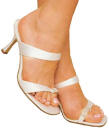Happy Feet
 I hope you’ll want to learn more and let me help you to get into the best shape of your life.
I hope you’ll want to learn more and let me help you to get into the best shape of your life.
Summer may be a time to wiggle your toes and run barefoot on the beach but more than half of American men and women say they regularly experience foot pain that interferes with their daily activities. Women seem to be more prone to foot problems and 84% have reported that they’ve experienced some sort of foot ailment. Here are some of the most common problems and the treatments for them which may help you to ‘get back on your feet.’
BUNIONS
Bunions are a bump that develops toward the base of your big toe, and can become swollen and painful. Bunions often are hereditary but also can be caused by faulty foot biomechanics and arthritis.
To avoid bunions, stay away from pointy, narrow shoes. Try to wear shoes with a wide toe box and good support, such as sneakers. Custom orthotics (inserts that fit into a shoe to hold your foot in the correct position) also may slow the development of a bunion.
Treatments: Padding or taping the affected foot can relieve bunion pain, and so can orthotics, anti-inflammatory medications, or steroid injections. In severe cases, surgery may be an option.
HEEL PAIN
Heel pain is most commonly caused by plantar fasciitis, an inflammation of the long band of connective tissue that runs from the heel to the ball of your foot. The bottom of the heel and arch of the foot can become very painful, especially with the first step in the morning or after resting and then getting up. Common causes are excessive running, jumping, or any other activity that stresses the tissues of the feet, obesity, and high or low arched feet. Pain also may be caused by a stress fracture of your heel.
To help avoid heel pain, begin your exercise program gradually and wear supportive shoes.
Treatments: Stretch before exercising. If you experience heel pain, follow the RICE principle; rest, ice, compression, and elevation. If this doesn’t help, your doctor may recommend orthotic devices, steroid injections, anti-inflammatory medications, or surgery.
TOENAIL PROBLEMS
About 18% of Americans suffer from onychomycosis, a fungal infection of your toenail. Nails can become thick, discolored, loose, brittle, and painful. Feet exposed to a warm, dark, moist environment can get infected, but some people may be genetically predisposed to fungal nails. For those who are susceptible, the condition is highly contagious.
To avoid keep your feet clean and dry, washing them at least once a day and drying the toes well. Make sure your shoes and socks stay dry, and change them daily. Wear socks that are either a natural/synthetic blend or wicking acrylic, which prevents moisture from becoming trapped against your skin.
Treatments: A podiatrist may remove the infected nail, painlessly removing it if necessary, and prescribes medication.
HAMMERTOES
With its distinctive profile a bending at the first joint causes the toe to look like an upside down “V” when viewed from the side. A hammertoe commonly is caused by increased tightening of your tendons and ligaments of your foot. This may lead to arthritic changes in your bone and joint that can become permanent and painful over time. Some people have a hereditary tendency to develop hammertoes, but they also may arise from a biomechanical deformity, such as a bunion. Hammertoes also are a symptom of rheumatoid arthritis.
Avoid wearing shoes that are too tight or narrow in the toe, as well as heels higher than 2 inches, which put pressure on the front of your foot.
Treatments: Non medicated hammertoe pads, available over the counter, will decrease pressure on the affected area. If pain persists, your doctor may provide special padding, orthotics, or custom shoes. Surgery is also an option.
CORNS AND CALLUSES
Many people have protective layers of compacted, dead skin cells that gather on bony areas of your foot. Corns are smaller and typically found over joints, while calluses develop on weight-bearing areas. Both are caused by friction and unnatural pressures.
To avoid you should wear shoes that give your toes enough room to move while supporting your foot without sliding or rubbing.
Treatments: Over-the-counter protective pads will cushion the areas often rubbed by your footwear. Be careful of using products called “corn or callus removers” because they may contain harsh ingredients that can cause a chemical burn. Your doctor can shave the corn or callus if it is necessary. In some cases, surgery is recommended to remove the deformity that is causing the problem.
IT STARTS WITH YOUR SHOES
Wearing the right shoes can prevent many of these foot ailments from developing.
- Make sure your shoes fit. Get your feet measured once a year. Your shoe size changes with your age and hormone fluctuations. Remember to go shoe shopping at the end of the day, when your feet are at their largest.
- Make sure there’s enough space in the toe so your toes have room to move.
- Shoes that are too narrow or too wide may cause sliding and rubbing that could lead to blisters and calluses.
- Avoid heels higher than 2 inches. High heels increase pressure on the front of your foot.
I know you want to get in shape and look great. Whatever your fitness goal…to slim down…gain muscle…tone your arms or flatten your tummy…I’m here to help you accomplish your goals and to improve your fitness level. If you have enjoyed this article and the many other free features on my site, and would like some more comprehensive information such as fitness books and CD’s to aid you in achieving your health and fitness goals, please visit myONLINE STORE where you will find innovative natural health and beauty products to help you become the BEST YOU CAN BE !

